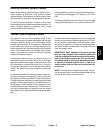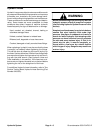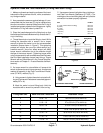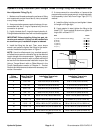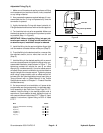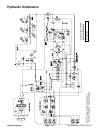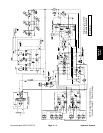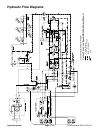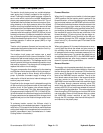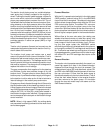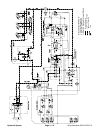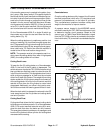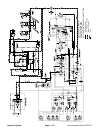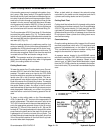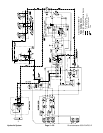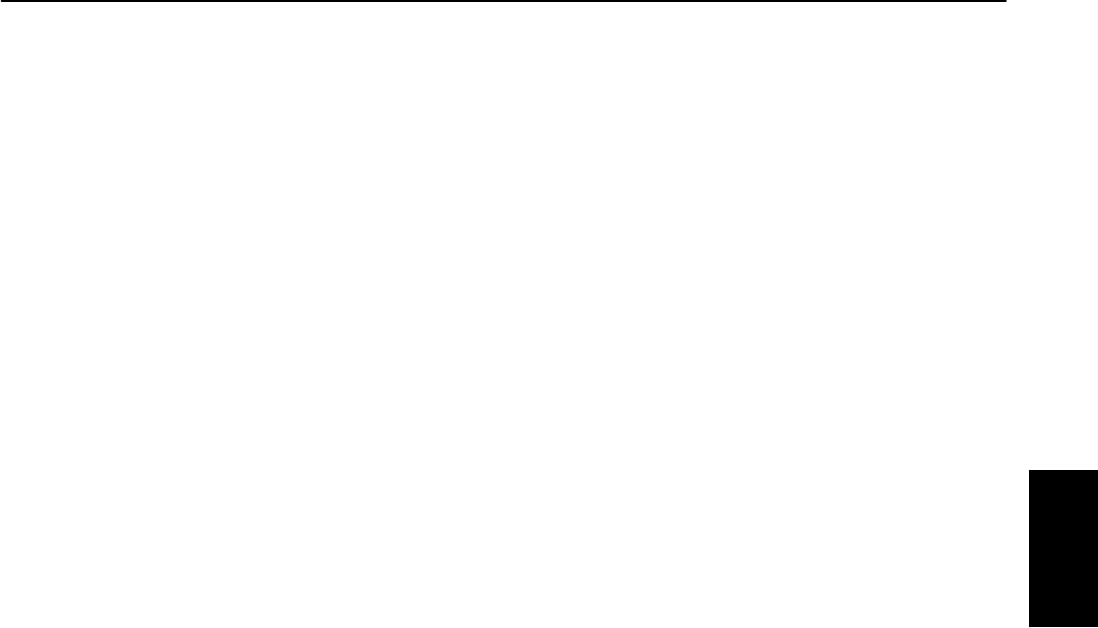
Groundsmaster 4500--D/4700--D Hydraulic SystemPage 4 -- 13
Traction Circuit: Low Speed (4WD)
The traction circuit piston pump is a variable displace-
ment pump that is directly coupled to the engine fly-
wheel. Pushing the traction pedal engages a hydraulic
servo valve which controls the variable displacement
piston pump swash plate to create a flow of oil. This oil
isdirected tothe frontwheel andrearaxle motors.Oper-
ating pressure on the high pressure side of the closed
traction circuit loop is determined by the amount of load
developedatthefixed displacementwheeland axlemo-
tors. As the load increases, circuit pressure can in-
creasetoreliefv alve settings:5000PSI(345bar) inboth
forward and reverse. If pressure exceeds the relief set-
ting, oilflows through therelief valve to thelow pressure
sideoftheclosedlooptractioncircuit.Thetractioncircuit
provides operation in either low speed (4WD) or high
speed (2WD).
Traction circuit pressure (forward and reverse) can be
measured at test ports located on the traction circuithy-
draulic tubes of the machine.
The traction circuit pump and motors use a small
amount of hydraulic fluid for internal lubrication. Fluid is
designed to leak across traction pump and motor com-
ponents into the case drain. This leakage results in the
lossofhydraulic fluidfromthe closedlooptraction circuit
that must be replaced. The charge circuit is designed to
replace this traction circuit leakage.
The gear pump section that supplies oil to the steering
and lift/lower circuits also prov ides oil for the charge cir-
cuit. This gear pump is driven directly off the traction
pump. It provides a constant supply of charge oil to
make up for oil that is lost due to internal leakage in the
traction pump and motors.
Pump flow for the charge circuit is directed through the
oil filter and to the low pressure side of the closed loop
traction circuit. A filter bypass valve allows charge oil
flow to the closed loop if the filter becomes plugged.
Charge pressure is limitedto 207 PSI (14.3 bar) bya re-
liefvalvelocatedinthefiltration/chargecontrolmanifold.
Charge pressure can be measured at the charge circuit
pressure test port on the filtration/charge control man-
ifold.
To enhance traction control, the lift/lower circuit is
equipped with a counterbalance system. A proportional
reliefvalve(TS) locatedin thelift control manifold allows
cutting deck weight to be transferred to the machine for
traction improvement (see Counterbalance in Lower
Cutting Decks in this section).
Forward Direction
Whenthe Hi--Lo speedcontrolswitch isin the lowspeed
(4WD) position and the traction pedal is pushed in the
forward direction, oil from the piston pump is directed to
the front wheel motors and 4WD/2WD control manifold.
Oilflow to thefront wheelmotors drivesthe motors inthe
forward direction and then returns to the piston pump.
Oil flow to the 4WD/2WD control manifold enters the P1
port and then is directed to the PD1 cartridge and out of
the manifold M1 port to drive the rear axle motor in the
forward direction. Oil returning from the rear motor re--
enters the 4WD/2WD control manifold at the M2 port.
Flow passes through the PD2 cartridge, through the
check valve (CV), out manifold port P2 and back to the
piston pump.
When goingdown a hill,the machinebecomes an over--
running load that drives the wheel and axle motors. In
this condition, the rear axle motor could lock up as the
oil pumped from the motor increases pressure as it re-
turns to the piston pump. To prevent rear wheel lock up,
an adjustable relief valve (RV) in the 4WD/2WD control
manifold reduces rear axle motor pressure created in
down hill, dynamic braking conditions.
Reverse Direction
The traction circuit operates essentially the same in re-
verse 4WD as it does in theforward direction. However,
the flow through the circuit is reversed. Oil flow from the
piston pump is directed to the front wheel motors and
also to the 4WD/2WD control manifold. The oil to the
front wheel motors drives them in the reverse direction
and then returns to the piston pump. The oil to the
4WD/2WD control manifold enters the manifold at port
P2 and flows through pressure reducing valve (PR)
which limits the down stream pressure to the rear axle
motorto450PSI(31 bar)sotherearwheels willnotscuff
theturfduring reverseoperation. Thisreduced pressure
flows through the PD2 cartridge and out port M2 to the
rear axlemotor. Returnoil from therear motor re--enters
the 4WD/2WD control manifold at port M1, flows
through the PD1 cartridge, exits the manifold at port P1
and returns to the piston pump.
Hydraulic
System



